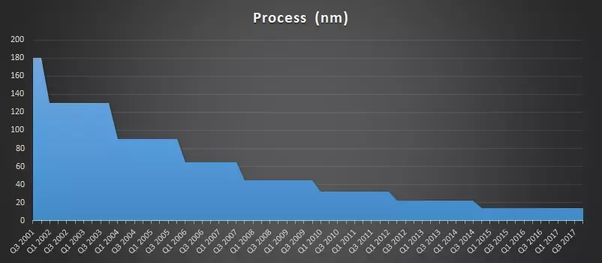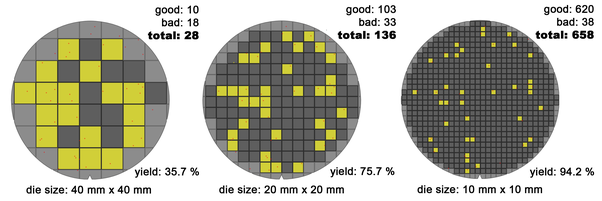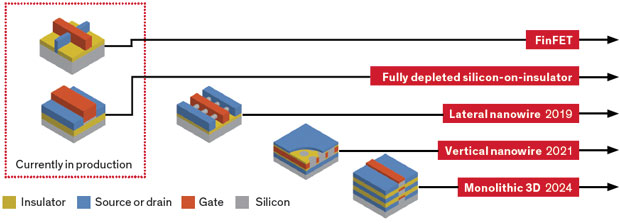Mobile Applications (or Apps), Video Games, accurate weather forecasts, and prominent medical research, and much more are just some of the life-changing miracles that the reliable and exponential growth of computer processing has brought about. This rapid advancement is credited to Moore’s law. However, people do not understand the weight of Moore’s Law. Let’s take another complex industry like Automotive Industry, if it had grown as fast as Semiconductor Industry, then we would be having cars closer to the Speed of Light, but everything must come to an end and Moore’s Law doesn’t seem well.
What is Moore’s Law? What does it mean for you?
In 1965, Gordan Moore, Intel’s co-founder published a paper titled, “Cramming More Components onto Integrated Circuits” where he established the economics of semiconductors and what will push the development of semiconductors. In his theory he stated cost per component is inversely proportional to the number of components in a circuit, meaning with an increase in the number of components, the price per component decreases.
If we combine this with the famous Dennard Scaling Law: Every successive generation the area per transistor (component) lowers by 50% while the power consumption reduces by 50%. Boom we get, Double the number of components (Transistors) per unit area while keeping power consumption constant every year.
This is the most common interpretation of Moore’s Law which everyone conveys. However, Moore’s Law is not a ‘Law’ per se but is just a quantitative prediction. So, Moore’s Law means doubling the transistors every year, we have achieved this by making the transistors smaller and smaller. However, this will not work for long and this trend has already slowed down.

Moore’s Law has long been associated with the exponential growth of the semiconductor industry. It is because of Moore’s Law that phones and laptops have gotten so far in such a short period. Don’t you find it strange that just 10 years ago you were playing ‘Snakes’ on your Nokia but now you can play Console-Quality games on your phone? Apart from better graphics Moore’s Law has brought about better Medical and Science Research and Accurate Weather Forecasting too.
One may be thinking, Aren’t computers fast enough? No, they are not. To show you an example here is a Molecular Dynamic Simulation that simulates a protein molecule’s path in the bloodstream, this is a very complicated task and is critical for understanding how it interacts with chemicals in your body. Even one of the fastest processors on the market an AMD EPYC 64c/128t CPU can only simulate 19.6 nanoseconds (19.6ns) of that molecule in one day. This was for medical research, computing is still not fast enough to do Artificial Intelligence, Self-Driving Cars, and Real-Time 3D Simulations (Photorealistic Graphics in Games), etc.

Apart from performance, Moore’s Law also plays a vital part in the economics of the semiconductor industry. Moore’s Law has pushed the semiconductor industry and investors to invest more capital and resources to keep Moore’s Law alive. It is mind-boggling that it had held up true for the last 50 years. Investors and analysts become frightened when they hear Intel saying ’Moore’s Law is Dead’ and that’s quite sad as Intel is supposed to be the Moore’s Law company.
No More Moore – The end of a beautiful era. What now?

‘Moore’s Law is Dead’ is a famous statement that has been stated by various famous personalities in the semiconductor industry like David Patterson, Jensen Huang, etc. This just means that we can’t go shrinking transistor sizes, for example, DRAM chips (that make-up RAM) is stuck in a 10nm trap. However, the real question is, What Now? How can we keep getting exponential growth in a semiconductor? Well, there are few ways that the clever EEE engineers have thought about like:
- Integrating Better Materials with Silicon to make Chips: We can use better materials like GaAs (Gallium Arsenide) to increase the performance of chips as these materials have higher electrons and holes for mobility. Intel has already started work on this.
- Use TFETs over MOSFETs: TFETs are similar to MOSFETs but have different important switching mechanisms which make more efficient than MOSFETs. MOSFETs are switches and are used in low power portable devices and wearables like Apple Watch. TFETs will essentially make them more energy efficient.
- Larger Die Size? Not Quite. Large

Image Source: pcgameshardware If we can’t make the components (transistor) small, can’t we just make the chip bigger to fit in more components? No, we can’t. The simple reason is yield. So, processors and chips are made out of a ‘wafer’, a wafer serves as the foundation to make chips, this is just silicon that has gone through special methods to make it suitable for semiconductor manufacturing. Not every chip that is made out of a wafer is equal, it has some defects.

Image Source: spectrumm Percentage of Good Number of Chips obtained gives us the yield. More the Yield, More the Number of Good Chips.

Image Source: wikipedia So, we can’t make bigger dies, but we can make Bigger Chips made out of Smaller chips. Gordon Moore had already predicted this “It may prove to be more economical to build large systems out of smaller functions” and this is happening right now. AMD’s Ryzen CPUs which make up the fastest CPUs in the market are made using the ‘Chiplet’ design. In short, it’s glueing together small CPUs to make one big CPU, I am simplifying it too much but you get the idea.
- Going from 2D to 3D: Well, if we are running out of space in the 2D space, let’s just stack circuitry (transistors) on top of each other. That’s what the focus of Intel is right now. Their end goal 3D Monolith design will enable them to have high-performance chips in small form factors. This design has turned out well for the storage industry and will also turn out great for the CPU industry.

Image Source: spectrum.ieee
Future of Computing:
The semiconductor industry has grown amazingly fast but in a few years’ technology companies will have to work harder to bring in the ‘next big thing’. We need a radical change. The basic requirement for the ‘next big thing’ is that it should be ten-fold as fast as the existing solutions and should be equivalent in price, if not cheaper. This may sound very optimistic but the future is not very far.
We have solutions like Quantum Computers and FPGAs (Field Programmable Gate Arrays) that can do a particular work faster than any classical computer in the world. Microsoft has gotten amazing results by using FPGAs for Artificial Intelligence and Google achieved ‘Quantum Supremacy’ with their Quantum Computer, Sycamore [Quantum Supremacy means when Quantum Computer can do a work that a Classical(Normal) Computer can’t.]

One of the biggest misconceptions surrounding these solutions is that they will replace the existing computers. This is completely false; the reality is that they will co-exist with Classical Computers. FPGAs are programmable devices that are specifically made for Machine Learning and Artificial Intelligence, they can only do some of the works that a Classical Computer can do. As for Quantum Computers, they are unpredictable, meaning, you can ask a Quantum Computer ‘What is 1+1?’ It will answer ‘It is 2, but I am 50% sure’, it gives answers in probability, this is because Quantum Computers work on Quantum Physics and not the Newtonian Physics that Classical Computer use, everything is random and complex in the Quantum World. Therefore, we need a Classical Computer to keep the Quantum Computer in check.
These are just things that are in the works right now. No one has seen the future, who knows What will be the future? Cloud Computing may be a possibility with the introduction of 5G. The fact of the matter is that people won’t be just upgrading for ‘speed’ but better software and features too. For the Chip Manufacturers, the times are extremely uncertain, there will a lot of winners and losers in this transition. Maybe new players will enter the field and gobble up the old giants, it’s just a matter of Survival of The Fittest.
Also Read: Remote Play From Xbox Is Now Available For iPhones
For the latest update about Gadgets & Gizmos browse through our Tech & Automobiles Section here: https://thesecondangle.com/category/tech/









